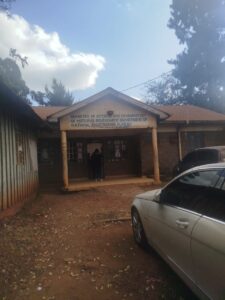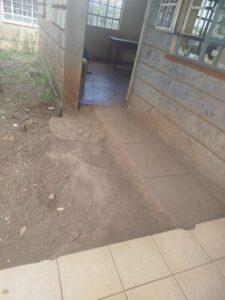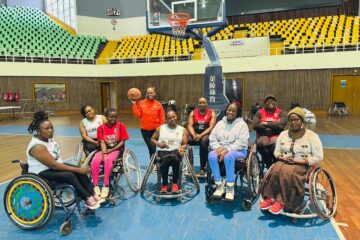What happens when the place you go to seek help is the very place that shuts you out? How? Well, let me tell you a story about the most inaccessible office I have been to and how that inaccessibility made me feel.
Over the weekend, I went to apply for Social Health Authority (SHA) services at a Government office. Like many Kenyans, I was hopeful. I’d heard about the shift from NHIF to SHA, how it promised a new, more inclusive way of doing things.
It was supposed to be a simple errand, just walk into the offices and apply manually like they said. Only, “walk in” doesn’t really apply to someone who rolls in.

As soon as I got to the building, my hope began to shrink. The entrance wasn’t designed for people like me. It looked like a ramp, but in reality, it was a stretch of bare, uneven concrete slapped onto the side of the entrance.
I just stared at it. No railings. No smooth surface. No consideration.

Entrance to the office
I felt sad first. Then angry. Because in that moment, it was clear—this wasn’t just poor design. This was exclusion. This was someone somewhere deciding that people like me didn’t need access. That our presence wasn’t anticipated, or worse, that we’d figure it out.
I hate being carried. It makes me feel small. Not because I don’t appreciate the help, but because I shouldn’t need to be lifted to enter a public building. Not in 2025. Not when we’re talking about essential services like healthcare.
I kept thinking: this is a public office. This is supposed to be for all of us. And yet, the structure tells a different story. A story where disability is still an afterthought. Where accessibility is still seen as a privilege, not a right. What if I had come alone? Would I have had to turn back? Would I have sat outside and waited, hoping someone would notice me?
What’s frustrating is that I am not the only one. There are so many people with disabilities who are sent away silently, their needs unmet simply because the environment is too hostile. We rarely talk about these silent rejections. The kind that doesn’t involve anyone telling you “no” directly—but the infrastructure does. And it does so loudly. It screams, “you don’t belong here.”
SHA is supposed to be the gateway to accessible healthcare in Kenya. It is meant to embody equity. But what happens when the gate itself is locked for some of us? How many people turned around that day, the previous day or over the years? How many gave up entirely because the journey inside required being carried, humiliated, or exposed?
And yet, I’m holding onto hope.
Earlier this year, Kenya passed the Persons with Disabilities Act, 2025. It replaces the outdated 2003 Act and brings a lot more bite to the fight for equality. For the first time, accessibility isn’t a polite request. It’s a demand. Public institutions are now legally required to provide accessible infrastructure. If they fail, adjustment orders can be issued, and failure to comply can result in serious penalties. That is powerful.
Section 21 of the Act specifically mandates that public buildings must be made accessible to persons with disabilities. It doesn’t end there. The Act also provides for time-bound implementation and empowers the National Council for Persons with Disabilities (NCPWD) to monitor compliance. For example, institutions that do not comply within a given period can face fines or even suspension of services.
What’s more, the Act recognizes that disability rights are human rights. It reaffirms our right to access healthcare, education, and employment—without begging, without waiting for someone’s good grace. It also gives the NCPWD real enforcement power. Finally, we’re not just hoping for change—we have the law on our side.
That doesn’t mean everything is perfect. Far from it. But it means we can now name the injustice and back it up with legal strength. We can file complaints. We can push for change. And, more importantly, we can dream again.
I dream of a day when applying for healthcare won’t come with fear of humiliation. When a building like that Government office doesn’t make me feel like an afterthought. I dream of a Kenya where accessibility isn’t a special feature, it’s the norm. Where ramps are not just built but built well, where consultation with people with disabilities is standard practice, not an afterthought.
This weekend shook me. It reminded me that progress is a journey, and sometimes we have to pause, look around, and say, “This isn’t good enough.” Because it isn’t. But there’s power in naming it. There’s power in sharing it. And there’s power in believing that we deserve better.
We do.
And so, we push forward. We advocate. We raise our voices. We hold our institutions accountable. We cling to hope, not because it’s easy, but because it’s necessary.
Because true accessibility doesn’t begin at the entrance of a building.
It begins with the belief that we all belong inside.



1 Comment
They Told Me to Be Quiet About My Disability - Unbroken Steps · July 16, 2025 at 7:32 am
[…] now moves differently.They’ll call you “inspiring” and “brave” — but never hire you.They’ll say “you’re so strong,” and still leave buildings without ramps or accessible washroo…That’s the contradiction we live with. Every single […]